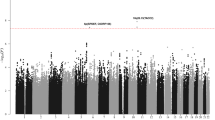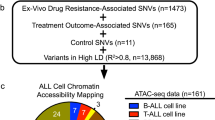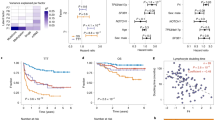Abstract
Publicly available genetic and expression data on lymphoblastoid cell lines (LCLs) make them a unique resource for understanding the genetic underpinnings of pharmacological outcomes and disease. LCLs have been used for pharmacogenomic discovery and validation of clinical findings associated with drug response. However, variation in cellular growth rate, baseline Epstein–Barr virus (EBV) copy number and ATP levels can all be confounders in such studies. Our objective is to better define confounding variables that affect pharmacological end points in LCLs. To this end, we evaluated the effect of these three variables on drug-induced cytotoxicity in LCLs. The drugs evaluated included daunorubicin, etoposide, carboplatin, cisplatin, cytarabine, pemetrexed, 5′-deoxyfluorouridine, vorinostat, methotrexate, 6-mercaptopurine, and 5-fluorouracil. Baseline ATP or EBV copy number were not significantly correlated with cellular growth rate or drug-induced cytotoxicity. In contrast, cellular growth rate and drug-induced cytotoxicity were significantly, directly related for all drugs except vorinostat. Importantly, cellular growth rate is under appreciable genetic influence (h2=0.30–0.39) with five suggestive linkage regions across the genome. Not surprisingly, a percentage of SNPs that significantly associate with drug-induced cytotoxicity also associate with cellular growth rate (P⩽0.0001). Studies using LCLs for pharmacologic outcomes should therefore consider that a portion of the genetic variation explaining drug-induced cytotoxicity is mediated via heritable effects on growth rate.
This is a preview of subscription content, access via your institution
Access options
Subscribe to this journal
Receive 6 print issues and online access
$259.00 per year
only $43.17 per issue
Buy this article
- Purchase on Springer Link
- Instant access to full article PDF
Prices may be subject to local taxes which are calculated during checkout



Similar content being viewed by others
Abbreviations
- 5′-DFUR:
-
5′-deoxyfluorouridine
- 5-FU:
-
5-fluorouracil
- AraC:
-
cytarabine
- ASN:
-
Asian
- ATP:
-
adenosine tri-phosphate
- CEPH:
-
Centre d'Etude du Polymorphisme Humain
- CEU:
-
Caucasians
- DNA:
-
deoxyribonucleic acid
- EBV:
-
Epstein–Barr virus
- h2:
-
heritability
- HapMap:
-
International HapMap Project
- LOD:
-
logarithm of odds
- LCL/s:
-
lymphoblastoid cell line/s
- QTDT:
-
Quantitative Transmission Disequilibrium Test
- RNA:
-
ribonucleic acid
- SNP/s:
-
single nucleotide polymorphism/s
- YRI:
-
Yoruba
References
Gipps EM, Kidson C . Cellular radiosensitivity: expression of an MS susceptibility gene? Neurology 1984; 34: 808–811.
Jen KY, Cheung VG . Transcriptional response of lymphoblastoid cells to ionizing radiation. Genome Res 2003; 13: 2092–2100.
Dixon AL, Liang L, Moffatt MF, Chen W, Heath S, Wong KC et al. A genome-wide association study of global gene expression. Nat Genet 2007; 39: 1202–1207.
Morley M, Molony CM, Weber TM, Devlin JL, Ewens KG, Spielman RS et al. Genetic analysis of genome-wide variation in human gene expression. Nature 2004; 430: 743–747.
Stranger BE, Forrest MS, Dunning M, Ingle CE, Beazley C, Thorne N et al. Relative impact of nucleotide and copy number variation on gene expression phenotypes. Science 2007; 315: 848–853.
Spielman RS, Bastone LA, Burdick JT, Morley M, Ewens WJ, Cheung VG . Common genetic variants account for differences in gene expression among ethnic groups. Nat Genet 2007; 39: 226–231.
Storey JD, Madeoy J, Strout JL, Wurfel M, Ronald J, Akey JM . Gene-expression variation within and among human populations. Am J Hum Genet 2007; 80: 502–509.
Stranger BE, Nica AC, Forrest MS, Dimas A, Bird CP, Beazley C et al. Population genomics of human gene expression. Nat Genet 2007; 39: 1217–1224.
Zhang W, Duan S, Kistner EO, Bleibel WK, Huang RS, Clark TA et al. Evaluation of genetic variation contributing to differences in gene expression between populations. Am J Hum Genet 2008; 82: 631–640.
Dolan ME, Newbold KG, Nagasubramanian R, Wu X, Ratain MJ, Cook EH et al. Heritability and linkage analysis of sensitivity to cisplatin-induced cytotoxicity. Cancer Res 2004; 64: 4353–4356.
Watters JW, Kraja A, Meucci MA, Province MA, McLeod HL . Genome-wide discovery of loci influencing chemotherapy cytotoxicity. Proc Natl Acad Sci USA 2004; 101: 11809–11814.
Shukla SJ, Duan S, Badner JA, Wu X, Dolan ME . Susceptibility loci involved in cisplatin-induced cytotoxicity and apoptosis. Pharmacogenet Genomics 2008; 18: 253–262.
Duan S, Bleibel WK, Huang RS, Shukla SJ, Wu X, Dolan ME . Mapping genes that contribute to daunorubicin-induced cytotoxicity. Cancer Res 2007; 67: 5425–5433.
Huang RS, Duan S, Bleibel WK, Kistner EO, Zhang W, Clark TA et al. A genome-wide approach to identify genetic variants that contribute to etoposide-induced cytotoxicity. Proc Natl Acad Sci USA 2007; 104: 9758–9763.
Huang RS, Duan S, Shukla SJ, Kistner EO, Clark TA, Chen TX et al. Identification of genetic variants contributing to Cisplatin-induced cytotoxicity by use of a genome-wide approach. Am J Hum Genet 2007; 81: 427–437.
Huang RS, Kistner EO, Bleibel WK, Shukla SJ, Dolan ME . Effect of population and gender on chemotherapeutic agent-induced cytotoxicity. Mol Cancer Ther 2007; 6: 31–36.
Hartford CM, Duan S, Delaney SM, Mi S, Kistner EO, Lamba JK et al. Populuation-specific genetic variants important in susceptibility to cytarabine arabinoside cytotoxicity. Blood 2009; 113: 2145–2153.
Li L, Fridley B, Kalari K, Jenkins G, Batzler A, Safgren S et al. Gemcitabine and cytosine arabinoside cytotoxicity: association with lymphoblastoid cell expression. Cancer Res 2008; 68: 7050–7058.
Jones TS, Yang W, Evans WE, Relling MV . Using HapMap tools in pharmacogenomic discovery: the thiopurine methyltransferase polymorphism. Clin Pharmacol Ther 2007; 81: 729–734.
Welsh MM, Mangravite L, Medina MW, Tantisira K, Zhang W, Huang RS et al. Pharmacogenomic discovery using cell-based models. Pharmacol Rev 2009; 61: 413–429.
Choy E, Yeleknsy R, Bonakdar S, Plenge RM, Saxena R, De Jager PL et al. Genetic analysis of human traits in vitro: drug response and gene expression in lymphoblastoid cell lines. PLoS Genet 2008; 4: e1000287.
Almasy L, Blangero J . Multipoint quantitative-trait linkage analysis in general pedigrees. Am J Hum Genet 1998; 62: 1198–1211.
Abecasis GR, Cherny SS, Cookson WO, Cardon LR . Merlin—rapid analysis of dense genetic maps using sparse gene flow trees. Nat Genet 2002; 30: 97–101.
Abecasis GR, Cardon LR, Cookson WO . A general test of association for quantitative traits in nuclear families. Am J Hum Genet 2000; 66: 279–292.
Tveit KM, Fodstad O, Pihl A . The usefulness of human tumor cell lines in the study of chemosensitivity. A study of malignant melanomas. Int J Cancer 1981; 28: 403–408.
Shukla SJ, Duan S, Wu X, Badner JA, Kasza K, Dolan ME . Whole-genome approach implicates CD44 in cellular resistance to carboplatin. Hum Genomics 2009; 3: 128–142.
Galmarini CM, Mackey JR, Dumontet C . Nucleoside analogues: mechanisms of drug resistance and reversal strategies. Leukemia 2001; 15: 875–890.
Rabik CA, Njoku MC, Dolan ME . Inactivation of O6-alkylguanine DNA alkyltransferase as a means to enhance chemotherapy. Cancer Treat Rev 2006; 32: 261–276.
Walko CM, Lindley C . Capecitabine: a review. Clin Ther 2005; 27: 23–44.
Meresse P, Dechaux E, Monneret C, Bertounesque E . Etoposide: discovery and medicinal chemistry. Curr Med Chem 2004; 11: 2443–2466.
Wang B, Perchellet EM, Wang Y, Tamura M, Hua DH, Perchellet JP . Antitumor triptycene bisquoinones: a novel synthetic class of dual inhibitors of DNA topoisomerase I and II activities. Anticancer Drugs 2003; 14: 503–514.
Bleibel WK, Duan S, Huang RS, Kistner EO, Shukla SJ, Wu X et al. Identification of genomic regions contributing to etoposide-induced cytototoxicity. Hum Genet 2009; 125: 173–180.
Acknowledgements
This work was supported by the Pharmacogenetics of Anticancer Agents Research Group by the National Institute of Health/National Institute of General Medical Sciences Grant U01GM61393, data deposits are supported by UO1GM61374 (http://pharmgkb.org/) and NIH/NCI Breast SPORE P50 CA125183. We acknowledge Dr Sunita J Shukla, Dr Christine M Hartford, Ms Bridget E McIlwee, and Mr Wasim Bleibel for results from their cytotoxicity growth inhibition experiments and Mr Steven J Stark for excellent technical assistance.
Author information
Authors and Affiliations
Corresponding author
Ethics declarations
Competing interests
The authors declare no conflict of interest.
Additional information
Supplementary Information accompanies the paper on the The Pharmacogenomics Journal website
Rights and permissions
About this article
Cite this article
Stark, A., Zhang, W., Mi, S. et al. Heritable and non-genetic factors as variables of pharmacologic phenotypes in lymphoblastoid cell lines. Pharmacogenomics J 10, 505–512 (2010). https://doi.org/10.1038/tpj.2010.3
Received:
Revised:
Accepted:
Published:
Issue Date:
DOI: https://doi.org/10.1038/tpj.2010.3
Keywords
This article is cited by
-
Extensive epigenetic and transcriptomic variability between genetically identical human B-lymphoblastoid cells with implications in pharmacogenomics research
Scientific Reports (2019)
-
Pharmacogenetics of Chemotherapy-Induced Cardiotoxicity
Current Oncology Reports (2018)
-
Molecular insight into thiopurine resistance: transcriptomic signature in lymphoblastoid cell lines
Genome Medicine (2015)
-
Functional analysis and molecular characterization of spontaneously outgrown human lymphoblastoid cell lines
Molecular Biology Reports (2014)
-
Sex Differences in Human Lymphoblastoid Cells Sensitivities to Antipsychotic Drugs
Journal of Molecular Neuroscience (2013)



